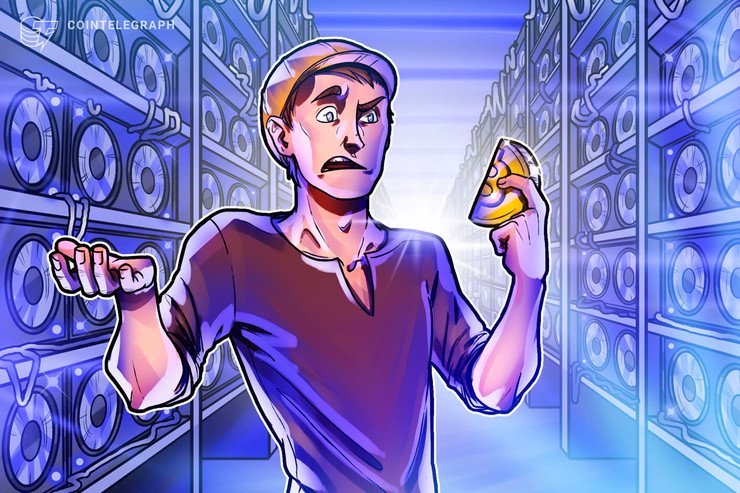With the COVID-19 pandemic grabbing most headlines the past few weeks, the cryptosphere has been directing some of its attention toward Bitcoin’s reward halving. With the event just four weeks away and the Bitcoin Cash and Bitcoin SV halvings already executed, the anticipation for Bitcoin’s halving is at an all-time high.
“Bitcoin halving” interest rising over time. Source: Google Search Trends
The halving grants Bitcoin (BTC) one of its most important features — its deflationary status. Bitcoin started out with 50 BTCs being created with each block, which took approximately 10 minutes to mine, but this rate is subsequently cut in half every four years. The upcoming halving will be the third of its kind and will reduce the Bitcoin issuance rate to 6.5 BTC for every 10 minutes of mining.
The halving is a highly anticipated event for industry insiders, with many having a bullish outlook for the price after the issuance is reduced. Production is cut in half, and many expect the demand to stay the same or to increase, which means the price would be bound to increase according to the laws of supply and demand.
However, the price doesn’t always do what’s expected, and it is possible that Bitcoin’s price will remain the same, or even drop after the halving. There are a lot of pieces affecting the price, including trader speculation. Margin trading in futures, for example, has been known to be a driving force in the price of Bitcoin when volatility ensues, which was visible during the crash of March 12–13 that led many leveraged positions to be liquidated. The current correlation with the stock market is another example of how Bitcoin’s price does not conform to the rationale of supply and demand.
Miners also affect the price
While speculation is certainly a driving factor for Bitcoin’s volatility, miners are also an important factor, accounting for a large percentage of sell pressure in BTC since they actually need to liquidate their mined coins in order to keep their operations running. Apart from other exchanges, miners account for the majority of exchange inflow, and while traders usually buy and sell Bitcoin, miners only sell.
Given that miners are a big piece of the Bitcoin puzzle, it’s important to understand how they have been preparing for the upcoming halving and the unknown price action that will ensue. The last big crash led to the biggest mining difficulty drop since 2011 and further accentuated the sell pressure from miners, many of whom were forced to shut down their operations as profitability dropped.
This process, described in a report by Blockware Solutions as “miner capitulation,” leads to a change in the mining ecosystem that rewards more advanced operations — which have the possibility to hold Bitcoin for a longer period and to change the dynamic of when and for how much newly minted BTCs will be sold.
Bitcoin’s price didn’t rise. Wait. What?
If prices increase substantially, there won’t be much to worry about because miners will receive fewer coins but will be able to sell each one for a higher value. This creates a big question: What will each miner do, and how will the network behave as a whole if prices stay the same, or even worse, in case they drop? While a change in price would be the end for many miners, each operation has a different break-even price, and more importantly, a different strategy.
If Bitcoin holds its current price ($6,800 at the time of writing) and production is cut to half, then miners will face a similar scenario as they did when the price crashed on March 12–13. This would be a problem for a considerable part of the network, which still relies on old generation equipment like the Antminer S9.
Those running the Antminer S9 and those who have low electricity fees of $0.03–$0.05 for a kilowatt-hour need the price to stay at $7,600–$13,000 after the halving in order to turn a profit — and that’s assuming the difficulty doesn’t change much. When taking into account additional hosting fees and even higher electricity prices practice in countries outside of China, the break-even price becomes even higher.
Thus, Bitcoin’s halving could force a vast majority of Antminer S9s or any older generation equipment out of the network. According to Blockware Solutions, Antminer S9s make up approximately 30% of the Bitcoin network hash rate — with the vast majority of these being used by miners with kWh prices of $0.03 and above.
This means that if old gen equipment goes dark, there will be a significant drop in difficulty which, in turn, would make mining more profitable for those who stay, as they would get a bigger piece of the new BTC pie. According to Matt D’Souza, the CEO of Blockware Solutions, a crypto mining solutions company, the difficulty drop can even surpass that of the March 12–13 crash. He told Cointelegraph:
“The decrease in difficulty after halving is completely determined on the margins of miners, which the Bitcoin price influences. If Bitcoin is below $9,000, then margins will be poor for miners. If Bitcoin remains at $7,200, then many miners will need to shut off. It will likely be about 27%–35% of the network if Bitcoin remains below 9,000 for several weeks post-halving.”
So what about miners with new generation equipment? Given that the recent Antminer S17 is able to mine 300% times faster than S9s for a 50% increase in electricity consumption, the breakeven price with the same electricity price of $0.03–$0.05 comes at around $3,000–$5,000.
This means that mining operations with higher electricity costs can stay in the game as well, even if the price stays the same, while old gen equipment is disabled, and the difficulty is reduced once more. In a recent Chainalysis webinar, Chris Bendiksen, the head of research at CoinShares, noted this very pattern during the recent crash in March, which he believes may have served as a “test-run” for the halving. Bendikson stated:
“The result being that after the halving passes, plus maybe some months of potential hazard volatility, the industry, the mining industry will be in a much stronger position with an overall lower cost base.”
Hedging: Futures and options
If the price holds the current levels or even drops, the new-gen equipment can stay in the game, even in areas where electricity is relatively expensive. Said operations have had a bigger incentive to stay up to date when it comes to newly released equipment, given that their breakeven price with the S9s would be hard to reach. This signals that such operations may have higher access to capital and, consequently, different strategies for their operations.
Selling Bitcoin in the spot market as new coins are mined is the most straightforward method for miners to keep their operations running and to profit from the endeavor. There are different strategies that involve different degrees of risk, reward and initial capital. This is the case with derivatives trading that allows miners to hedge against price fluctuations in Bitcoin.
Miners can look to futures or options contracts in order to ensure that they are not too affected by short term volatility by either shorting BTC through a futures contract or buying an option contract that allows them to sell BTC at a determined price in the future — the strike price.
While this strategy requires capital, miners have a few available options from private investment to peer-to-peer loans and even credit lines from popular cryptocurrency apps like Nexo or BlockFi — which has recently announced it is extending credit to miners for the first time.
Miners still have a few tricks
There are other steps miners can take to protect themselves if derivatives hedging is not an option. For example, many mining operations have been known to provide colocation services in their self-mining operations. This allows them to make the most out of the available space and to earn from hosting and charging for electricity fees.
Mobile mining units have also been gaining traction as of late, and, although they are not a great solution for those who already have a running operation, they present a cost-effective way for small scale miners to start earning even after the halving. Another step miners with old equipment or new operations can take is sticking to a schedule where they buy a certain amount of rigs every month to capture cheap pricing on rigs when manufacturers lower the prices. D’souza pointed out the importance of purchasing equipment at the right time:
“Deployment into rigs at the right time is critical — Blockware Solutions advises its clients on when to leave old gen and get into new gen. We had our clients selling their old gen in May–June 2019 and to buy the next gen so they are well prepared.”
Miners can also upgrade to new gen equipment to reduce their exposure to the post-halving price action, selling their current equipment to miners with cheaper or free electricity. Some miners are also inherently protected, like those with subsidized electricity or even power plants that use their excess electricity to power mining equipment.
Lastly, another option is to stop mining Bitcoin altogether and switch to another coin with the same mining algorithm. However, Bitcoin miners are known to be die-hard fans and don’t show the same flexibility as GPU miners, for example. So, switching may not be an option for some.
The Bitcoin show must go on
Miners can leverage various tools within the crypto space to protect themselves for the unknown that will follow the halving. Of course, those with a higher appetite for risk and a bullish outlook on Bitcoin, can stick with their current strategy and just keep on mining, hoping the price goes up as they did after previous halvings.
Nevertheless, it is unlikely that Bitcoin will enter a “death spiral” as some have suggested. Reduced difficulty and hedging strategies ensure that mining will likely always be profitable for some at certain points in time. The halving will take place, and Bitcoin will just continue its journey, one block at a time.




